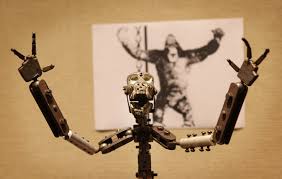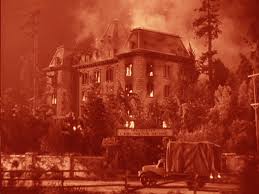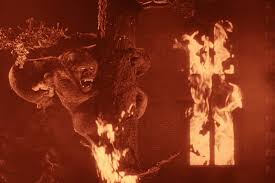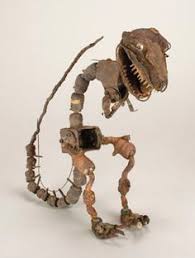"I don't wanna work in the movies. I want to be an artist".
Should I mention the 1933 classic motion picture “King Kong” two names will immediately come to mind: Merian C. Cooper and Willis O’Brien. Should I mention the 1949 Academy Award winning motion picture “Mighty Joe Young” three names immediately come to mind and possibly a fourth: Merian C. Cooper, Willis O’Brien and his protégé Ray Harryhausen. The possible fourth being Executive Producer John Ford.
_movie_poster_(1).jpg)
However, there is a forgotten name:
Marcel Delgado that without his work and invention neither of those films might have had so memorable title characters.
Unfortunately very little has been written about him and most of what is posted on the web turns out to be about a model of King Kong he made for the Don Post Studio’s in 1968, see the picture below, and not the man himself.
Even his one paragraph obituary gives little detail other than mentioning the 1933 motion picture “King Kong”. Go to the Turner Classic Website and the sites filmography for Marcel Delgado only lists the 1933 "King Kong" and the 1949 "Mighty Joe Young". As for his occupation TCM indicates he was only part of the “Tech Staff”. I could only find one other filmography that mentions the 1935 “The Last Days of Pompeii”, but a complete list of his work seems unknown. To the motion picture industry Marcel Delgado seems to have worked upon only two movies, but I was able to put the following biography together and it is sadly an incomplete life.
Marcel Delgado was born January 16, 1901 in La Parrita, Coahulia, Mexico. By the age of six Marcel was attempting to make toys and models from river clay and began dreaming of becoming an artist. In 1910 his family left Mexico to escape the revolution that was sweeping people up.


Marcel Delgado's family moved to the unincorporated community of Saticoy, California in Ventura County. Where they became farm laborers. Little else is known about Marcel's formative years in Ventura County. Except after his father passed away the young man was forced to leave school to head the family.

We do know it wasn’t until Marcel was 17 that he found it necessary to learn English and by that time the family was relocated to Los Angeles. Between working at a convenience/grocery store in 1921 Marcel Delgado started to take art lessons at the Otis Arts Institute now known as Otis College of Art and Design. The Art School was established in 1918 and in the 1940’s had as a Staff Teacher Norman Rockwell. I had to track down references about the school and noted the school’s listing of its famous graduates starting in 1920 does not contain Marcel Delgado’s name.
Marcel Delgado's family moved to the unincorporated community of Saticoy, California in Ventura County. Where they became farm laborers. Little else is known about Marcel's formative years in Ventura County. Except after his father passed away the young man was forced to leave school to head the family.

We do know it wasn’t until Marcel was 17 that he found it necessary to learn English and by that time the family was relocated to Los Angeles. Between working at a convenience/grocery store in 1921 Marcel Delgado started to take art lessons at the Otis Arts Institute now known as Otis College of Art and Design. The Art School was established in 1918 and in the 1940’s had as a Staff Teacher Norman Rockwell. I had to track down references about the school and noted the school’s listing of its famous graduates starting in 1920 does not contain Marcel Delgado’s name.
While Marcel Delgado was at the school Willis O”Brien realized a need for a sculptor on a film he was about to start work upon. “Obie” because of his work on such Dinosaur shorts for the Edison Company as “R.F.D. 10,000 B.C.” and 1918’s “The Ghost of Slumber Mountain” had been hired by First National Pictures, the future 20th Century Fox, to make Sir Arthur Conan Doyle’s “The Lost World” into a film. Creating his Prehistoric creatures for those previous few minute long films required only wooden armatures which could break easily. O’Brien knew he needed metal armatures with the ability to be moved into different positions and that was above him at the time. Making inquiries he was led to the Otis Institute and a student named Marcel Delgado.
In an interview Delgado stated:
“Mr. O'Brien took an interest in my work and one night he asked me, 'would you like to work in motion pictures?' I told him I would not because I wanted to be an artist and didn't want to lose any time. Every time he saw me he asked again and offered me $75 a week to come to work for him. I always said no, and I really know why; I was only making $18 a week but I guess I felt secure. One Friday he asked me to lay off work and visit the motion picture studio. Obie left a pass at the gate and when I went in Obie met me and took me to his little shop. There was a 'phone, some cameras and pictures all around. 'How do you like your studio?' he asked. 'It's yours if you want it.' It was a twenty-year-old boy's dream! So I signed up and worked for the next couple of years building dinosaurs for The Lost World.”
http://silentmoviemonsters.tripod.com/TheLostWorld/LWDELGADO.html
---and the team of O’Brien and Delgado was born.
From Ray Harryhausen’s excellent book “A Century of Stop Motion Animation”:
“Before Delgado began work on the models Obie designed more technically advanced ball-and socket armatures made of aluminum which improved on the previous designs, allowing for smoother animation and better rigidity during photography. Delgado made clay models of the main creatures based on Obie’s drawings to work from and began to construct the bodies on the armatures. He started by placing rough rubber muscles on various parts of the armature (if a bladder was to be used this would of course be inserted first) which would stretch and change shape realistically when the joints were moved to different positions. He then stuffed the metal ribcage and the outer area of the armature with cotton, forming the basic shape of the animal which was then covered with latex rubber. Finally the models were painted in colours that would ‘reflect’ best in black and white photography. Although relatively crude by today’s standards the models were state of the art in the early 1920’s and today still have a quality of innocence and charm”
As the above paragraph indicates Willis O’Brien was the designer and Marcel Delgado the forgotten model maker. Both men would do the animation of the dinosaurs. Delgado described what happened at the end of a day’s shoot:
“During the course of production, after the day’s work was over, these puppets had to be restored, groomed, repaired if broken. They had to be in perfect condition for the next day. Many times they were torn down completely to overhaul the steel skeleton when it was worn out. This happened frequently and it was quite a chore to maintain them in animating condition.”
A requirement for later films such as “King Kong” and “Mighty Joe Young”. Once more illustrating what work Marcel Delgado actually did as a member of what TCM described aspart of Willis O’Brien's “Tech Staff”. A “Tech Staff” of two that would eventually grow to three with the edition of another member of Marcel’s family, his, also unknown brother Victor. In all there were 49 different Dinosaurs made for the movie.


In 2001 a restored edition of the 1925 “The Lost World” was released on DVD.
Stan Winston stated:
In 2001 a restored edition of the 1925 “The Lost World” was released on DVD.
Stan Winston stated:
“Our creature animation in the Jurassic Park films basically descends from The Lost World of 1925. Willis O’Brien is our great pioneer, and this superb restoration inspires new awe for his imagination and craftsmanship”.WInston's statement has no mention of the man who made the armatures and co-animated the film is made. Once more indicating how forgotten Marcel Delgado is today.
The DVD runs 93 minutes and contains footage discovered in Romania actually doubling the length of most versions that where known to still exist. There was one I saw decades ago at approximately 58 minutes, but it was said some of the scenes where out of order. It is estimated from production notes that there is between 45 minutes to an hour of additional footage still lost.


What Marcel Delgado did between 1925 and 1931 when work began on “King Kong” I can find no references. We know that Obie worked on a series of cancelled projects for First National Studios two of which were entitled “Atlantis” and “Frankenstein”. One has to wonder what his version would have looked like as it would have pre-dated Universal Studio’s James Whale production starring Boris Karloff and Colin Clive.
We know that O’Brien and Delgado started work in 1931 for RKO on a cancelled project entitled “Creation”. Does this sound somewhat familiar? It was about modern men encountering dinosaurs on an island. Only 20 minutes of footage was shot and apparently 4 minutes of it is still around today. Oh, the man who cancelled O’Brien’s film was RKO Studio’s head of production Merian C. Cooper. He was afraid the film sounded too close to his own pet project about a giant gorilla battling Komodo dragons and the pre-work on “King Kong” started.
Here is a drawing for "Creation":

Here is a drawing for "Creation":
Marcel Delgado would work on both the 1933 “King Kong” and 1933 “Son of Kong” creating the armatures for the different stop motion characters. The armatures he made for the several Kong puppets just needed servicing and the fur covering changed to become either Kong’s son, or “Mighty Joe Young”.
Marcel Delgado holding one of the large hands of Kong for close-ups,

The armatures for "King Kong"



The armature for the Brontosaurus in 1933's "King Kong".


Marcel Delgado holding one of the large hands of Kong for close-ups,
The armatures for "King Kong"
The armature for the Brontosaurus in 1933's "King Kong".
I could find nothing on Marcel Delgado between 1935’s “The Last Days of Pompeii” where he worked as a model maker until he resurfaces first in 1941 as “one of the crew” on Orson Wells’ “Citizen Kane”.

Then after another eight years in 1949 Marcel Delgado resurraces to help film a couple of small scenes such as Joe claiming the tree at the orphanage during the first sequence in “Mighty Joe Young”.




It appears Marcel Delgado must have just become one of the contract technicians working films as assigned by RKO pictures, but even that is impossible to say for sure. Ray Harryhausen’s “A Century of Stop Motion Animation” mentions Delgado from time to time, but only in passing as his dinosaur armatures from as far back as 1925’s “The Lost World” were reused over the years by either Willis O”Brien or other stop motion animators on different films.
Then after another eight years in 1949 Marcel Delgado resurraces to help film a couple of small scenes such as Joe claiming the tree at the orphanage during the first sequence in “Mighty Joe Young”.
It appears Marcel Delgado must have just become one of the contract technicians working films as assigned by RKO pictures, but even that is impossible to say for sure. Ray Harryhausen’s “A Century of Stop Motion Animation” mentions Delgado from time to time, but only in passing as his dinosaur armatures from as far back as 1925’s “The Lost World” were reused over the years by either Willis O”Brien or other stop motion animators on different films.
I was able to find Delgado’s name associated with George Pal’s 1953 film “War of the Worlds" as an "un-credted" model builder.. The film won the Academy Award for Best Special Effects.

The following year the Academy Award for Best Special Effects went to the Walt Disney classic “20,000 Leagues Under the Sea”, Marcel Delgado was listed once more as an "un-credited" model builder..

What work Marcel Delgado did between 1954 and 1960 I could not locate anywhere. However, he became the "un-credited" dinosaur builder for 1960's semi-comical "Dinosaurus". The work was crude due to the limited budget.




Marcel Delgado's name,"un-credited", may also be associated with some early stop motion work by Jim Danforth, but this cannot be confirmed. Although some of his previously made armatures definitely where utilized by Danforth. Marcel Delgado would retire from motion pictures in 1965.
Besides the model of "King Kong" made in 1968 by Marcel Delgado for Don Post, He also created model heads, such as "King Kong", to be made into masks.
In 1970 Marcel Delgado gave an interview to Jim Lane. Here are the links to the three part posting on Lane's blog: Jim Lane's Cinedrome. It is very interesting and it appears to be the only known interview given by Delgado who six years later would pass away.
http://jimlanescinedrome.blogspot.com/2010/05/heres-job-for-you-marcel-part-1.html
http://jimlanescinedrome.blogspot.com/2010/05/heres-job-for-you-marcel-part-2.html
http://jimlanescinedrome.blogspot.com/2010/05/heres-job-for-you-marcel-part-3.html
As to Marcel Delgado's death and what caused it. The most I could find was it was a result of some unstated accident and that Marcel Delgado died on November 26, 1976. His work however is immortal and it is up to my reader mention it from time to time. At least whenever the 1933 "King Kong" plays.
The following year the Academy Award for Best Special Effects went to the Walt Disney classic “20,000 Leagues Under the Sea”, Marcel Delgado was listed once more as an "un-credited" model builder..
What work Marcel Delgado did between 1954 and 1960 I could not locate anywhere. However, he became the "un-credited" dinosaur builder for 1960's semi-comical "Dinosaurus". The work was crude due to the limited budget.

Marcel Delgado's name,"un-credited", may also be associated with some early stop motion work by Jim Danforth, but this cannot be confirmed. Although some of his previously made armatures definitely where utilized by Danforth. Marcel Delgado would retire from motion pictures in 1965.
Besides the model of "King Kong" made in 1968 by Marcel Delgado for Don Post, He also created model heads, such as "King Kong", to be made into masks.
In 1970 Marcel Delgado gave an interview to Jim Lane. Here are the links to the three part posting on Lane's blog: Jim Lane's Cinedrome. It is very interesting and it appears to be the only known interview given by Delgado who six years later would pass away.
http://jimlanescinedrome.blogspot.com/2010/05/heres-job-for-you-marcel-part-1.html
http://jimlanescinedrome.blogspot.com/2010/05/heres-job-for-you-marcel-part-2.html
http://jimlanescinedrome.blogspot.com/2010/05/heres-job-for-you-marcel-part-3.html
As to Marcel Delgado's death and what caused it. The most I could find was it was a result of some unstated accident and that Marcel Delgado died on November 26, 1976. His work however is immortal and it is up to my reader mention it from time to time. At least whenever the 1933 "King Kong" plays.



No comments:
Post a Comment